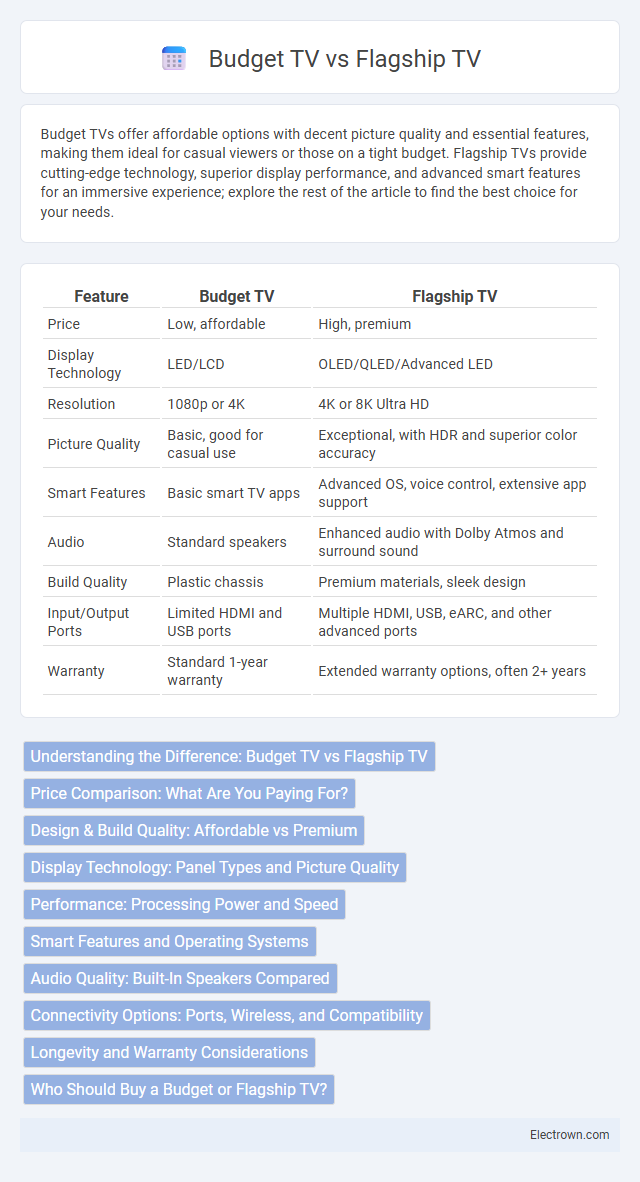Budget TVs offer affordable options with decent picture quality and essential features, making them ideal for casual viewers or those on a tight budget. Flagship TVs provide cutting-edge technology, superior display performance, and advanced smart features for an immersive experience; explore the rest of the article to find the best choice for your needs.
Table of Comparison
| Feature | Budget TV | Flagship TV |
|---|---|---|
| Price | Low, affordable | High, premium |
| Display Technology | LED/LCD | OLED/QLED/Advanced LED |
| Resolution | 1080p or 4K | 4K or 8K Ultra HD |
| Picture Quality | Basic, good for casual use | Exceptional, with HDR and superior color accuracy |
| Smart Features | Basic smart TV apps | Advanced OS, voice control, extensive app support |
| Audio | Standard speakers | Enhanced audio with Dolby Atmos and surround sound |
| Build Quality | Plastic chassis | Premium materials, sleek design |
| Input/Output Ports | Limited HDMI and USB ports | Multiple HDMI, USB, eARC, and other advanced ports |
| Warranty | Standard 1-year warranty | Extended warranty options, often 2+ years |
Understanding the Difference: Budget TV vs Flagship TV
Budget TVs offer essential features and satisfactory performance at a lower price point, making them ideal for cost-conscious consumers. Flagship TVs incorporate advanced technologies like OLED or QLED displays, superior processing power, and enhanced smart capabilities, delivering exceptional picture quality and user experience. Your choice depends on balancing price with features, ensuring you get the right TV that fits your viewing needs and budget.
Price Comparison: What Are You Paying For?
Budget TVs typically cost between $150 and $400, offering basic display technologies like LCD or LED with lower resolution and fewer smart features. Flagship TVs, ranging from $1,000 to over $3,000, provide advanced OLED or QLED panels, superior color accuracy, higher refresh rates, and extensive smart TV capabilities. Your investment in a flagship model ensures enhanced picture quality, durability, and cutting-edge technology that justify the higher price point compared to budget alternatives.
Design & Build Quality: Affordable vs Premium
Budget TVs prioritize affordability with plastic builds and simpler designs, often featuring thicker bezels and basic stands. Flagship TVs showcase premium materials such as metal frames, ultra-thin bezels, and sleek, minimalist designs, ensuring durability and aesthetic appeal. Your choice reflects a trade-off between cost-effective practicality and high-end craftsmanship.
Display Technology: Panel Types and Picture Quality
Budget TVs often use VA (Vertical Alignment) panels, offering higher contrast ratios but narrower viewing angles, while flagship TVs typically feature IPS (In-Plane Switching) or OLED panels that deliver superior color accuracy, wider viewing angles, and deeper blacks. OLED flagship models achieve pixel-level light control, resulting in exceptional picture quality with true blacks and vibrant colors, unlike budget TVs that rely on LED backlighting and local dimming. Advanced HDR support and higher refresh rates are standard in flagship displays, enhancing dynamic range and motion clarity beyond what budget panel technologies provide.
Performance: Processing Power and Speed
Flagship TVs typically feature advanced processors with higher clock speeds and multiple cores, resulting in smoother performance, faster app loading, and better handling of 4K or 8K content compared to budget TVs. Budget TVs often employ entry-level processors that may struggle with high-resolution streaming and complex smart features, leading to occasional lag or delayed response times. The enhanced processing power in flagship models ensures superior image upscaling, reduced motion blur, and more efficient multitasking capabilities.
Smart Features and Operating Systems
Budget TVs often run on simplified operating systems such as Roku, Fire OS, or proprietary platforms that provide essential smart features like streaming apps and screen mirroring but may lack the advanced customization and app variety found in flagship models. Flagship TVs typically feature more powerful operating systems like Android TV, webOS, or Tizen, offering a richer ecosystem with voice control, AI integration, and seamless connectivity with other smart devices. The enhanced user interface and frequent software updates on flagship TVs deliver a more responsive and versatile smart experience compared to budget options.
Audio Quality: Built-In Speakers Compared
Budget TVs typically feature basic built-in speakers with limited sound range and lower audio clarity, often resulting in a less immersive viewing experience. Flagship TVs are equipped with advanced audio technologies, such as Dolby Atmos or built-in soundbars, delivering richer, clearer sound with enhanced bass and surround effects. Your choice can significantly impact your overall entertainment quality, especially if you rely solely on built-in speakers without external audio equipment.
Connectivity Options: Ports, Wireless, and Compatibility
Budget TVs typically offer a limited number of ports such as HDMI 1.4 and USB 2.0, with basic wireless capabilities like Wi-Fi 4 and Bluetooth 4.0, which restrict high-speed data transfer and advanced peripheral connections. Flagship TVs feature multiple HDMI 2.1 ports, USB 3.0 or higher, and support the latest wireless standards including Wi-Fi 6 and Bluetooth 5.0, ensuring seamless compatibility with a wide range of devices and high-performance streaming. Enhanced connectivity options on flagship models enable compatibility with advanced gaming consoles, soundbars, and smart home ecosystems, providing superior flexibility and future-proofing.
Longevity and Warranty Considerations
Flagship TVs typically offer longer lifespans due to superior components and advanced build quality, supported by extended warranty periods that ensure comprehensive coverage. Budget TVs may have shorter longevity and limited warranty services, potentially requiring earlier replacements or repairs. Ensuring your investment aligns with your usage needs can maximize value and reliability over time.
Who Should Buy a Budget or Flagship TV?
Budget TVs suit buyers seeking affordability and basic functionality, ideal for casual viewers who prioritize cost-effectiveness over advanced features. Flagship TVs attract enthusiasts wanting premium picture quality, cutting-edge technology, and extensive smart capabilities, appealing to cinephiles and gamers demanding the best performance. Choosing between budget and flagship TVs depends on individual priorities such as usage, viewing experience, and budget constraints.
Budget TV vs Flagship TV Infographic

 electrown.com
electrown.com